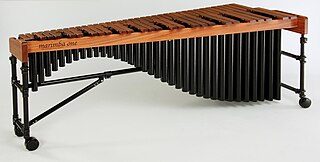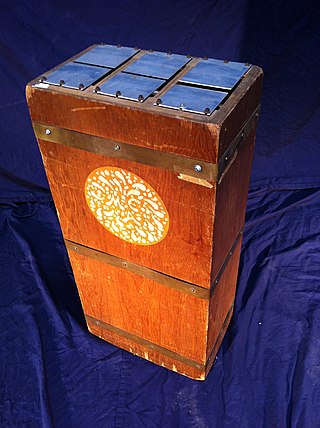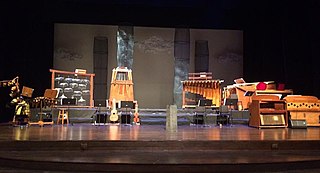
The drum is a member of the percussion group of musical instruments. In the Hornbostel-Sachs classification system, it is a membranophone. Drums consist of at least one membrane, called a drumhead or drum skin, that is stretched over a shell and struck, either directly with the player's hands, or with a percussion mallet, to produce sound. There is usually a resonant head on the underside of the drum. Other techniques have been used to cause drums to make sound, such as the thumb roll. Drums are the world's oldest and most ubiquitous musical instruments, and the basic design has remained virtually unchanged for thousands of years.

A percussion instrument is a musical instrument that is sounded by being struck or scraped by a beater including attached or enclosed beaters or rattles struck, scraped or rubbed by hand or struck against another similar instrument. Excluding zoomusicological instruments and the human voice, the percussion family is believed to include the oldest musical instruments. In spite of being a very common term to designate instruments, and to relate them to their players, the percussionists, percussion is not a systematic classificatory category of instruments, as described by the scientific field of organology. It is shown below that percussion instruments may belong to the organological classes of ideophone, membranophone, aerophone and cordophone.

The marimba is a musical instrument in the percussion family that consists of wooden bars that are struck by mallets. Below each bar is a resonator pipe that amplifies particular harmonics of its sound. Compared to the xylophone, the timbre of the marimba is warmer, deeper, more resonant, and more pure. It also tends to have a lower range than that of a xylophone. Typically, the bars of a marimba are arranged chromatically, like the keys of a piano. The marimba is a type of idiophone.
Hornbostel–Sachs or Sachs–Hornbostel is a system of musical instrument classification devised by Erich Moritz von Hornbostel and Curt Sachs, and first published in the Zeitschrift für Ethnologie in 1914. An English translation was published in the Galpin Society Journal in 1961. It is the most widely used system for classifying musical instruments by ethnomusicologists and organologists. The system was updated in 2011 as part of the work of the Musical Instrument Museums Online (MIMO) Project.
A membranophone is any musical instrument which produces sound primarily by way of a vibrating stretched membrane. It is one of the four main divisions of instruments in the original Hornbostel-Sachs scheme of musical instrument classification.

An idiophone is any musical instrument that creates sound primarily by the vibration of the instrument itself, without the use of air flow, strings (chordophones), membranes (membranophones) or electricity (electrophones). It is the first of the four main divisions in the original Hornbostel–Sachs system of musical instrument classification. The early classification of Victor-Charles Mahillon called this group of instruments autophones. The most common are struck idiophones, or concussion idiophones, which are made to vibrate by being struck, either directly with a stick or hand or indirectly, with scraping or shaking motions. Various types of bells fall into both categories. A common plucked idiophone is the Jew's harp.
Newband is a contemporary music ensemble devoted to the performance of microtonal music. The group was founded in 1977 by musicians Stefani Starin and Dean Drummond. As a youth, Drummond performed with maverick composer Harry Partch in a unique ensemble of microtonal instruments that Partch designed and built himself; Drummond performed in the premieres of Partch’s Daphne of the Dunes, And on the Seventh Day Petals Fell in Petaluma, and Delusion of the Fury, as well as on both Partch Columbia Masterworks recordings made during the late 1960s.

Hand percussion is a percussion instrument that is held in the hand. They can be made from wood, metal or plastic, bottles stops and are usually shaken, scraped, or tapped with fingers or a stick. It includes all instruments that are not drums or pitched percussion instruments such as the marimba or the xylophone.
David "Buck" Wheat was an American folk and jazz musician. The Texas-born Wheat was a guitarist and bass player with the dance bands of the era, playing at the Chicago Playboy Jazz Festival 1959 in The Playboy Jazz All Stars and the Chet Baker Trio. In the winter of 1957, he was a jazz guitarist with Baker's Trio. Though most of Baker's material was recorded in Los Angeles, "Embraceable You", "There's a Lull in My Life" and "My Funny Valentine" are rare examples of Baker recording in New York. The format is also unusual for him, just Baker's vocals accompanied by only Wheat on nylon string acoustic guitar and bassist Russ Savakus.
Traditional Thai musical instruments are the musical instruments used in the traditional and classical music of Thailand. They comprise a wide range of wind, string, and percussion instruments played by both the Thai majority as well as the nation's ethnic minorities.

Traditional Cambodian musical instruments are the musical instruments used in the traditional and classical music of Cambodia. They comprise a wide range of wind, string, and percussion instruments, used by both the Khmer majority as well as the nation's ethnic minorities.
This is a partitioned list of percussion instruments showing their usage as tuned or untuned. See pitched percussion instrument for discussion of the differences between tuned and untuned percussion. The term pitched percussion is now preferred to the traditional term tuned percussion:

An unpitched percussion instrument is a percussion instrument played in such a way as to produce sounds of indeterminate pitch, or an instrument normally played in this fashion.

There are several overlapping schemes for the classification of percussion instruments.

The lujon is a bass metallophone consisting of individually-pitched metal plates that are attached to the resonance chambers of a partitioned wooden box.

The American composer Harry Partch (1901-1974) composed using scales of unequal intervals in just intonation, derived from the natural Harmonic series; these scales allowed for more tones of smaller intervals than in the standard Western tuning, which uses twelve equal intervals. The tonal system Partch used has 43 tones to the octave. To play this music he invented and built many new instruments, with names such as the Chromelodeon, the Quadrangularis Reversum, and the Zymo-Xyl.










